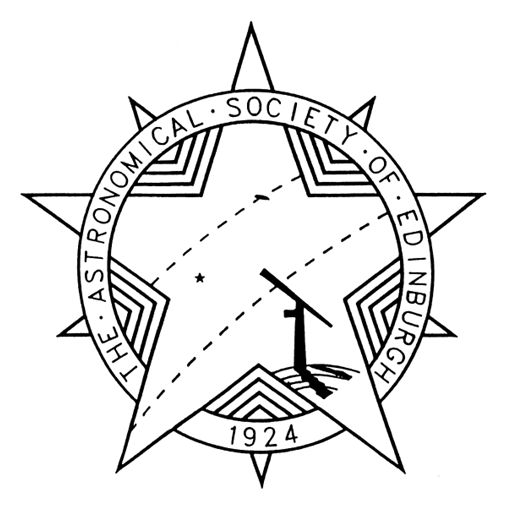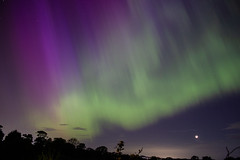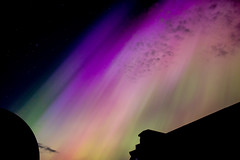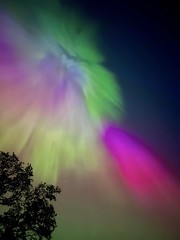Monthly Archives: November 2014
Scotland’s Sky in December, 2014
Jupiter outstanding as the Geminids meteors fly

The maps show the sky at 21:00 GMT on the 1st, 20:00 on the 16th and 19:00 on the 31st. (Click on map to englarge)
December brings our longest nights of the year and what may be 2014’s richest meteor shower. Indeed, there is an argument for ranking December nights as the most spectacular of the year if only because Orion, and the sparkling constellations that attend him, stand at their highest near the meridian at midnight. Of the bright planets, Jupiter outshines every star and is well placed from mid-evening onwards, but the others are lurking shyly near the Sun and require a little more effort.
Jupiter is unmistakable from the moment it rises in the east-north-east some 35 minutes after our star map times. Improving in brightness from magnitude -2.3 to -2.5 this month, it climbs to pass high in the south and onwards into the south-west before dawn. We find it in Leo, to the right of the Sickle and less than 8° above-right of Regulus. It is here that it reaches a stationary point on the 9th before beginning a westerly motion which carries it back into Cancer just a day before its opposition in early February.
With its large disk and changing cloud-patterns, Jupiter is always an rewarding telescopic sight while the motions from side to side of its four main moons may be followed using nothing more than decent binoculars. When Jupiter lies near the Moon on the night of the 11th-12th, it is 717 million km distant and its globe appears 41 arcsec in diameter.
Orion stands clear of the horizon in the east-south-east at the map times. Its main stars, the blue-white supergiant Rigel at Orion’s knee and the contrasting red supergiant Betelgeuse at his shoulder, are among the ten brightest. the trio of stars between them form Orion’s Belt while hanging below the Belt is Orion’s Sword and the fuzzy glow of the Orion Nebula where new stars and planets are forming, albeit slowly, before our eyes.
A line upwards along the Belt extends to Aldebaran (close to the Moon on the 5th-6th) and onwards to the Pleiades or Seven Sisters star cluster. Carry the line downwards towards Sirius which rises one hour after our map times and is our brightest star after the Sun.
North and east (above-left) of Orion lies Gemini with its twins Castor and Pollux, while close to Castor (see chart) is the radiant point for the annual Geminids meteor shower. Bright medium-slow meteors streak in all parts of the sky between the 8th and 17th but all radiate away from this point as they follow parallel paths into the upper atmosphere. The radiant climbs from the north-north-east horizon at nightfall to pass high in the south at about 02:00. Meteor rates are expected to be highest during the 24 hours around 07:00 on the morning of the 14th when more than 80 Geminids per hour might be counted under ideal conditions. The Moon is much less obtrusive than during the Geminids last year.
The Square of Pegasus crosses the high meridian in the early evening and shifts to the south-west by our map times as Andromeda stretches up from its upper-left corner. High in the south are the two smaller constellations of Triangulum the Triangle and Aries the Ram. Aries’ main star, Hamal, is identical in brightness to Polaris, the Pole Star, but lies perhaps five times closer to us at 66 light years, It also appears to have a planet that is larger than Jupiter and takes 381 days to orbit at a distance slightly greater than that between the Earth and the Sun.
Aries also gives its name to the celestial counterpart of the Greenwich meridian. Longitudes in the sky are measured eastwards from the so-called First Point of Aries where the Sun crosses the sky’s equator at the spring or vernal equinox. When the Greek astronomer Hipparchus assigned the name more than two thousand years ago this point was located in Aries. However, the Earth wobbles on its axis over a period of 26,000 years with the result that the First Point of Aries has slipped more than 30° westwards against the stars and now lies to the south of the Square of Pegasus in the dim constellation of Pisces.
The Sun is furthest south in the sky at 23:03 GMT on the 21st, the moment of our winter solstice. Sunrise/sunset times for Edinburgh change from 08:19/15:44 on the 1st, to 08:43/15:40 on the 21st and 08:44/15:48 on the 31st. Nautical twilight persists for around 94 minutes at dawn and dusk. The Moon is full on the 6th, at last quarter on the 14th, new on the 22nd and at first quarter on the 28th.
Mars, the best of the planets after Jupiter, is the brightest object low in the south-south-west at nightfall and climbs a little higher from night to night as it slides northwards in relation to the Sun. It does, though, dim from magnitude 1.0 to 1.1 as it tracks eastwards through Capricornus. It sets at about 19:15 and stands left of the young earthlit Moon on Christmas Eve.
By mid-month, and provided we have a clear south-western horizon, we may be able to spot the brilliant (magnitude -3.9) evening star Venus just after sunset. At Hogmanay, Venus stands 6° high at sunset and sets itself 76 minutes later. Mercury slips around the Sun’s far side on the 8th and is destined to join Venus as an evening star in the New Year.
Saturn is emerging as a pre-dawn object low in the south-east where it shines at magnitude 0.5 as it tracks from Libra into Scorpius. Catch it 7° below-left of the waning Moon on the 19th.
Alan Pickup
This is a slightly-revised version of Alan’s article published in The Scotsman on November 28th 2014, with thanks to the newspaper for permission to republish here.
Scotland’s Sky in November, 2014
Europe’s Philae probe to attempt first touchdown on comet

The maps show the sky at 21:00 GMT on the 1st, 20:00 on the 16th and 19:00 on the 30th. (Click on map to englarge)
In an exciting month in astronomy and space exploration, November should bring the first soft landing on a comet when the European Space Agency’s Philae craft detaches from the Rosetta probe and drops gently onto the icy nucleus of Comet Churyumov-Gerasimenko.
Our sky at nightfall s similar to that of a month ago although, with our return to GMT, darkness arrives more than two hours earlier in the evening. Mars continues as the only bright planet at these times, visible low in Edinburgh’s south-south-western sky and fading only a little from magnitude 0.9 to 1.0 as it tracks eastwards above the Teapot of Sagittarius.
However, even though Mars is drawing closer to the Sun, its altitude at the end of nautical twilight improves from 5° to 9° during November as the Sun plunges more than 7° southwards in the sky and Mars edges almost 3° northwards. This also means that Mars-set in the south-west occurs at about 19:05 throughout the period. It stands below the young crescent Moon on the 26th.
Sunrise/sunset times for Edinburgh change from 07:19/16:33 GMT on the 1st to 08:17/15:45 on the 30th as the duration of nautical twilight at dawn and dusk extends from 83 to 93 minutes. The Moon is full on the 6th, at last quarter on the 14th, new on the 22nd and at first quarter on the 29th.
Comet Churyumov-Gerasimenko lies 6° south-east of Mars on the 12th but is a very dim telescopic object some 450 million km from the Sun. On that day Philae is due to unlatch from Rosetta and take about seven hours to fall 22.5km, coming to rest on tripod legs at about 16:00 GMT atop the head of the comet’s strange “rubber-duck” shape. To stop itself bouncing off into space in defiance of the comet’s feeble gravitational pull, it should then fire a tethered harpoon to anchor itself to the surface.
The comet’s 6-year orbit is carrying it closer to the Sun, eventually to reach perihelion at a distance of 186 million km next August. Meantime, its activity is picking up and Rosetta is imaging jets of dust and gas emerging, mainly from the duck’s neck region at present. With Philae in position to also monitor conditions at the surface, and even below the crust using sonar, seismographs and permittivity probes, our knowledge of what makes comets tick should soon be transformed.
The Summer Triangle of Vega, Deneb and Altair, lies in the west at our map times as Orion rises in the east below Taurus and the Pleiades. The Square of Pegasus stands high on the meridian with the three main stars of Andromeda, Alpheratz, Mirach and Almach, leading off from its top-left corner. The Andromeda Galaxy, M31, could hardly be better placed, being visible to the naked eye in a decent sky and not difficult at all through binoculars. It stands 2.5 million light years (ly) away and appears as an oval smudge some 8° above Mirach.
A line through the Square’s two right-hand stars points the way to Fomalhaut, bright but very low in the south. I mentioned last time that it may have at least a couple of planets. In fact, the first so-called extrasolar planet circling a solar-type star was discovered in 1995 and is about half the size of Jupiter yet orbits in only 4.2 days at a distance only one seventh of that of Mercury from the Sun. The star concerned is 51 Pegasi, magnitude 5.5 and 50 ly distant, which is unmistakable through binoculars just 1.5° or 3 Moon-widths to the right of the Scheat-Markab line.
Of the 1,800-plus extrasolar planets now known, no less than four orbit Upsilon Andromedae, a fourth magnitude star at 44 ly that stands between Mirach and Almach (see chart).
Jupiter, is creeping eastwards to the right of the famous Sickle of Leo. Rising in the east-north-east at about 23:20 on the 1st and as early as 21:40 on the 30th, it is prominent until dawn as it climbs through our south-eastern sky to pass about 50° high on our meridian before dawn. The Jovian disk is 38 arcseconds across when Jupiter lies near the Moon on the night of 13/14th.
The annual Leonids meteor shower lasts from the 15th to the 20th, building to a sharp peak on the morning of the 18th. Its super-swift meteors flash in all parts of the sky, though their paths radiate from a point in the Sickle. There is little moonlight interference this year, but meteor rates may be well down on what they were a few years ago when the shower’s parent comet was in the vicinity.
Venus sets too soon after the Sun to be seen, and with Saturn reaching conjunction on the Sun’s far side on the 18th, our only other observable bright planet is Mercury, fortunately putting on its best morning show of 2014.
On the 1st Mercury rises two hours before the Sun and shines at magnitude -0.5 as it climbs to an altitude of 10° in the east-south-east forty minutes before sunrise. Although it soon brightens to magnitude 0.8, it also slips back towards the Sun, so that by the 14th it rises 89 minutes before the Sun and is 6° high forty minutes before sunrise. Given a clear horizon, though, binoculars should show it easily and it should be a naked-eye object until it is swamped by the brightening twilight. Look for Virgo’s leading star, Spica, climbing from below Mercury to pass 5° to its right on the 7th.
Alan Pickup



